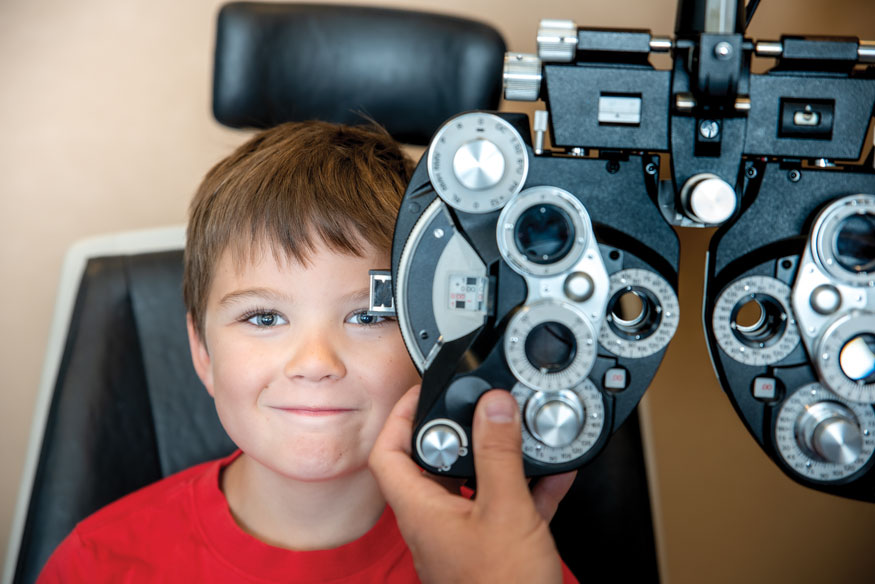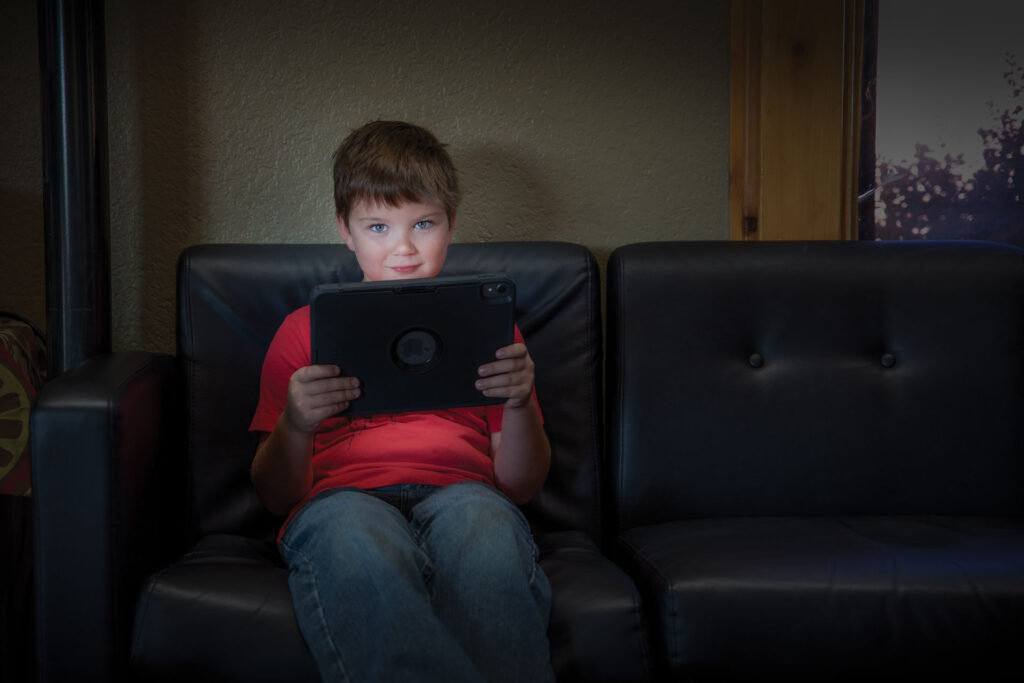For so long we’ve been told to limit our screen time, and for good reason: heavy computer use among children is linked to early myopia (nearsightedness) and causes strain, which stresses the eyes. But now that our computers are incredibly integrated with accessible learning, how do we protect our children’s eyes and keep their development healthy?
Visit the Professionals
Children can start seeing the optometrist as early as six months old (and in some circumstances, three months old). These initial visits not only get the child familiar with the new environment, but also allow the doctor to monitor healthy vision development.
80% of learning in the first 12 years of life comes through the eyes
The Discovery Eye Foundation (2014)
“We start seeing kids at six months,” said Dr. Jared Pearson at Vision Source Specialists. “Through these first appointments, we watch their eye development while they are learning through vision.”
Most children’s visual systems are developed by age eight or nine. However, if there are any issues with the efficiency or effectiveness of how their eyes take in information or work together, there may be issues with learning.
“We can detect vision issues from birth,” explained Dr. Ross English at Northern Hills Eye Care. “When we exam infants, we ensure the eyes are healthy both front and back. We determine the child’s refractive state (myopia, hyperopia, astigmatism) and make certain there is not a significant difference in the refractive error between the two eyes. We also make sure the eyes are aligned and work together as expected.”

Setting appointments early on in a child’s life will help relieve stresses and correct any vision problems that may develop.
According to Dr. Andrea Thau, president of the American Optometric Association, one in four children has an undiagnosed vision problem because changes in their eyesight go unrecognized by both the child and their parents or guardians.
20-30% of children have a vision-related problem beyond seeing 20/20. They have visual mechanical issues that are ineffective and inefficient–affecting their ability to read, learn, and comprehend the information they are seeing and reading.
Dr. Jared Pearson, Vision Source Specialists
“Making a comprehensive eye examination a priority this year is one of the single most important investments you can make in your child’s education and overall health,” she said.
Watch for Signs
More often than not, there are signs of vision problems that can be caught early. Whether your child is in classes or working on their lessons from home, look for signs of struggle to complete simple tasks—especially if they typically do well with other activities. Other signs of vision problems include short attention spans or difficulty maintaining focus, squinting or closing one eye, rubbing the eyes, and headaches that go away after resting from a focused activity like reading.
“Vision plays such a major role in the ability to read, learn, comprehend, and even pay attention,” explained Dr. Pearson. “Patients may be able to see 20/20 from far away or up close, but when it comes to partaking in an activity like reading, it may not be as clear.”
You should see an optometric physician if you are experiencing visual symptoms (eye strain, eye fatigue, headache, double vision, blurry vision). Seek immediate care if you have any sudden onset of eye pain, sudden changes or loss of vision, red eye, or flashes/floaters in your vision.
Dr. Ross English
Sometimes, our eyes don’t work in tandem, which can cause double vision or word/letter jumbling in sentence structures. Luckily, there are a variety of saccades (rapid eye movements), activities, and routines patients of all ages can seek out at facilities like Vision Sources’ Performance Vision Therapy Center. Here, they work with children, athletes, and adults to correct vision issues that cannot necessarily be solved with glasses or contacts.
Take a Break
We’ve heard it before, and it still reigns true year after year: give your eyes a break. According to a study by Common Sense Media, kids under age eight now spend an average of more than two hours a day viewing digital displays. Among older children (ages eight through 14), the screen time jumps between six and nine hours. However, there is more you can do to give your eyes a break than eliminating screen time altogether.
Practicing visual hygiene is recommended by many optometrists for both adults and children. For every 20 minutes of up-close activity (such as computer work or reading), focus your eyes on an object 20 feet away for 20 seconds and allow your eyes to blink 20 times.
“Our eyes are designed to see far away,” explained Dr. Pearson. “Therefore, giving your eyes a break by looking into the distance will release the tension in the muscles and may relieve strain on your eyes.

Other ways to help your student’s eyes while they are using their computer for extended time include adjusting the screen to eye level rather than looking up or down, working in a well-lit room, adding a matte screen filter to your monitor, and using a humidifier to reduce dry eyes.
Computers also use a source called blue light. If your screen time is extensive, it may be worth talking to your doctor about blue light or computer glasses. Giving your eyes a break from blue light is especially important before bedtime. Blue light is reported to reduce the production of melatonin, which allows our bodies to get the deep sleep we need for healthy immune systems and restoration. Both Dr. Pearson and Dr. English agree that ending screen time 90 minutes to two hours before bed will help your student sleep better throughout the night.
“I typically do not recommend blue blocking lenses unless somebody spends a significant amount of the day on digital devices and is still experiencing computer vision syndrome after doing the previous recommendations.”
Dr. Ross English
Our vision is crucial in allowing us to perform a variety of abilities, both physically and mentally. Checking your childrens’ eyes as they develop and monitoring their actions throughout the school year will not only help their success in education, but their stress levels in life. With clear, efficient vision, students’ tasks become easier to accomplish, which reaps tremendous rewards over time. Take notice this school year and protect your student’s eyes.
WORDS: JENNA CARDA
PHOTOS: JESSE BROWN NELSON

